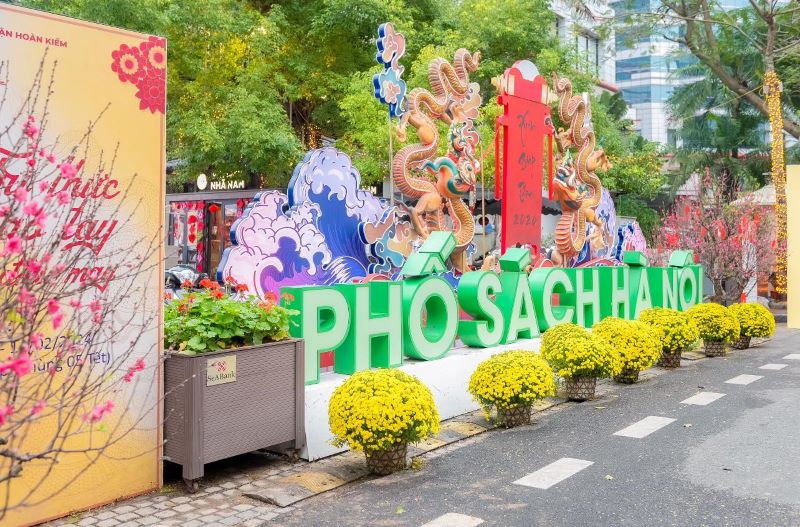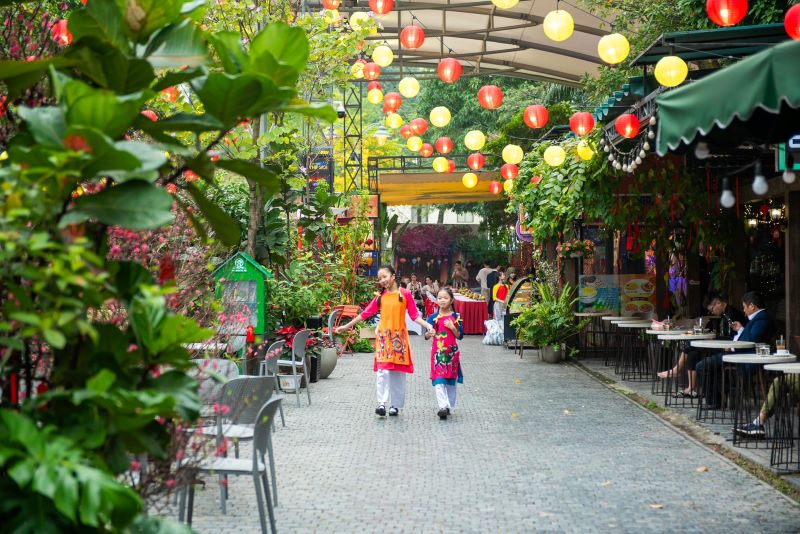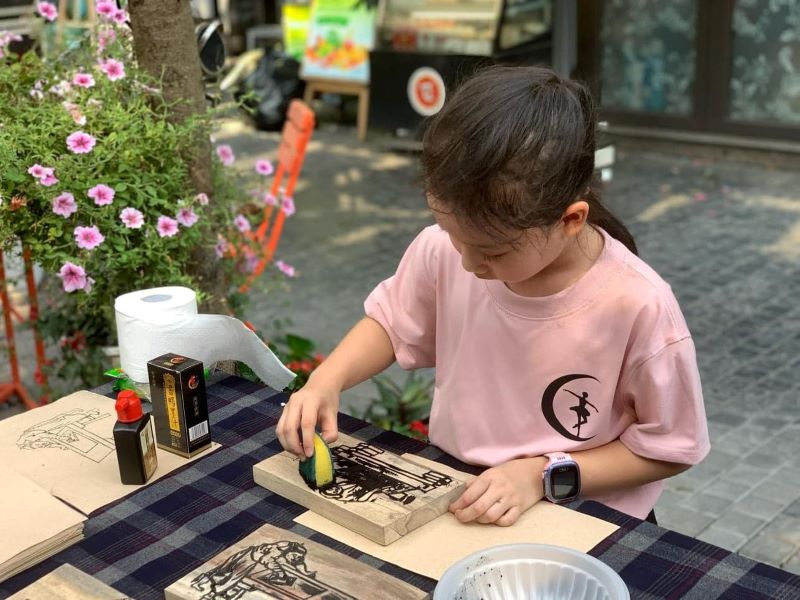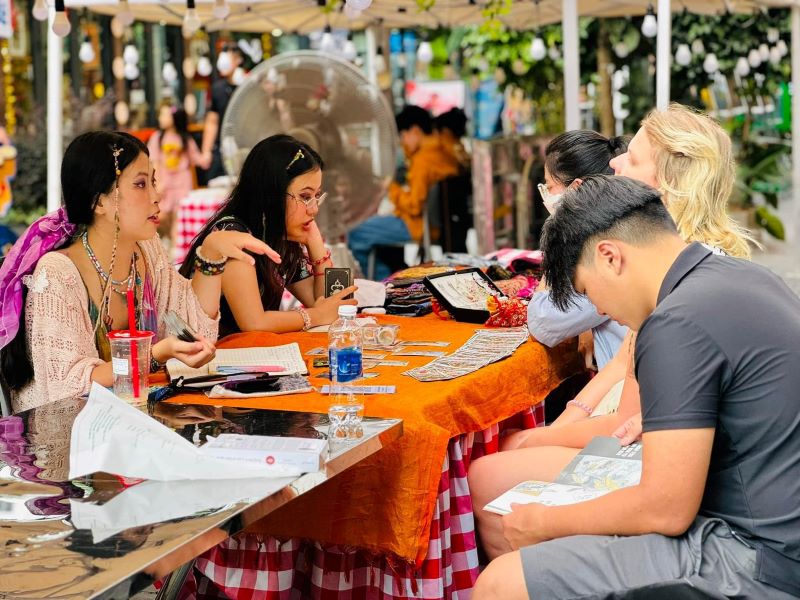
In the capital city, there is a special street with no house numbers, simply named after a date in a tragic year in the country's history of anti-colonial invasion. This is 19 Thang 12 (December 19) Street. Since many bookstores are located here, this street is also known as "Hanoi Book Street".
The street
| The colorful Hanoi Book Street of today. Photo: Pho sach 19/12 |
19 Thang 12 Street runs between the Supreme People's Court (the Court of Appeal during the French colonial period) and the Mélia Hanoi Hotel (then the Industrial School). It stretches more than 100 meters from Hai Ba Trung Street to Ly Thuong Kiet Street.
According to the book "Across Hanoi" by writer Nguyen Ngoc Tien, in 1900, the street was called Rue Palais de Justice (Palace of Justice Street), which was changed to Rue Paul Simoni (Paul Simoni Street) 33 years later.
In December 1945, Hanoi Mayor Tran Duy Hung renamed the street "Le Chan Street" - after a female general under the Trung sisters Hai Ba Trung, two national heroes who rebelled against Chinese Han invaders in 40 AD. This new name remained when Hanoi renamed its streets in 1949 and 1951.
Testimony to a fierce war
With the goal of retaking Hanoi in December 1946, the French army repeatedly found excuses to provoke the Viet Minh forces. On the morning of December 17, they brutally massacred innocent civilians on Hang Bun Street. Knowing that war was inevitable, President Ho Chi Minh issued a public appeal for national resistance on December 19.
| Book Street is a popular cultural destination in Hanoi. |
In response to his call, the 102nd "Capital" Regiment, along with the Hanoi Citadel Militia, opened fire on the French army that very evening. This marked a significant milestone: for the first time, the young Vietnamese army attacked the French right at their headquarters. Despite the disparity in strength and weapons, both the soldiers and the citizens were "determined to face death for the survival of the Fatherland.
They died fighting heroically at many barricades, but their bodies could not be recovered. After the fighting, French General Jean Valluy ordered his troops to throw these bodies into the bomb shelters on Le Chan Street.
These shelters were dug after the morning of March 24, 1944, when Allied planes bombed Japanese-occupied positions in the city. Sirens sounded, but civilians could not take shelter in the bunker built in the Court of Appeal because the doors were locked.
Witnessing this incident, lawyer Michel Dunezat sent a letter to the acting commissioner De Pereyra expressing his anger, who the next day had underground shelters dug along Le Chan Street, their roofs covered with wooden planks and earth.
| It's a place of interest in Hanoi where children can experience various cultural activities. |
The city was temporarily occupied by the French, who barricaded both ends of the street, leaving only a small path for civilians to enter and offer incense to the fallen. After the capital's liberation day (October 10, 1954), the new government beautified the graveyard, planted grass, and hung a sign at the end of Ly Thuong Kiet Street that read: "Tomb of the People and Soldiers Who Fought and Died on National Resistance Day - December 19, 1946".
In 1981, the city had the remains exhumed and buried at Bat Bat cemetery (now Yen Ky cemetery, Phu Son Commune, Ba Vi District). However, there was no record of the number of bone boxes, making it difficult to estimate the number of relocated dead.
The "Underground Market"
After the work was completed in 1984, the street was restored and given a new name: 19 Thang 12 or December 12 Market. To relieve overcrowding in Cua Nam and Hang Da markets, the city allowed Hoan Kiem District to set up a wet market here. Because it is located in a former burial ground, people call it the "underground market."
| The December 19 market or underground market in the 2000s. File Photo |
In 2008, the city closed the 3,054 square meter 19 Thang 12 Market and assigned Thu Do II Co., Ltd. to build a commercial center and office space for lease. The complex would have included two high-rise blocks with a total area of 19,013 square meters. One block has seven floors for offices and the other has 17 floors, with the bottom five floors for a traditional market and restaurants. However, the project did not receive the approval of historians, architects, and cultural researchers, so the city suspended it and switched to another project that included street renovation and the construction of a park.
In January 2009, while digging, workers found bones jumbled together under the road, indicating that the dead had been thrown on top of each other. After more than 10 days of searching up to 3.5 meters deep, the workers collected a huge amount of bones that filled 497 terracotta coffins.
| Book Street is now a popular destination for young people, both Vietnamese and foreigners. |
According to Vietnamese custom, the family can exhume the body at least three years after burial. By this time, the bones have usually not decomposed and should take up half of the usual bone coffin.
Based on 497 coffins full of bones, the number of deaths is estimated at about 1,000. It's worth noting that more than 60 years had passed and many smaller bones had decomposed, so the number of deaths could be even higher, not to mention the remains that were relocated in 1981, showing the gravity of the crime committed by the French troops against the capital city of Hanoi.
In addition to the bones, the recovery team also found 119 artifacts, including those that could help identify the dead as soldiers of the 102nd "Capital" Regiment, members of the Hanoi Citadel militia, women, prisoners, and so on.
Today’s cultural rendezvous
| International visitors to 19 Thang 12 Book Street |
Eight years after the project was completed, the city decided to turn the 19 Thang 12 street into a pedestrian book street. On April 30, 2017, the Hanoi Book Street officially opened, with a dozen bookstores, fresh flower stalls, and cafes.
An ideal place to buy books, read, socialize, learn about local history, and even take photographs, 19 Thang 12 Book Street has become a classic cultural destination for Hanoi residents and tourists alike.
Not only local people but also many tourists from other provinces and countries visit Hanoi Book Street when they come to Hanoi. The street is not only a place to sell books, but more importantly, it is a cultural place where book lovers can exchange, spread reading culture, and find valuable and timeless content and traces of the past.






- Untold tale of Hang Dau Water Tower
- Hanoi's lively Mid-Autumn Festival a century ago
- Kinh Thien Palace restoration: Reviving national history
- Explore historical relics on Ngoc Khanh Lake's new pedestrian path
- We're too censorious about heritage preservation efforts
- Hanoi's parks and flower gardens – little known stories




.jpg)

.jpg)